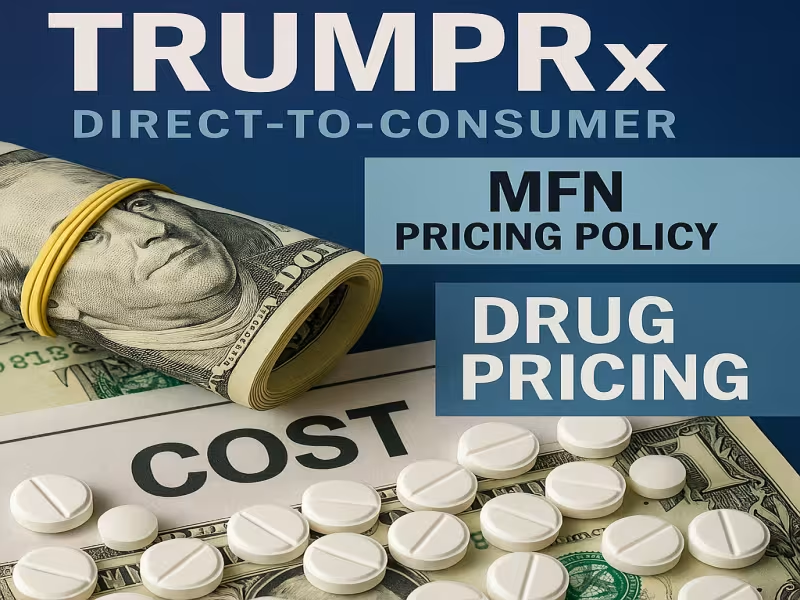
SHERIDAN, WYOMING - November 13, 2025 - As the federal government prepares to launch its TrumpRx direct-to-consumer platform in early 2026, U.S. drugmakers are accelerating their own discount initiatives in anticipation of sweeping pricing reforms tied to the Most Favored Nation (MFN) framework. Yet analysts and health economists warn that these programs-ranging from discounted dermatology creams to multi-billion-dollar GLP-1 therapies-may have limited influence on overall spending, with most insured patients unlikely to shift away from existing payer pathways.
A New Federal Push to Reset U.S. Drug Pricing Benchmarks
The Biden and Trump administrations have both leaned heavily on MFN pricing models to pull U.S. drug prices closer to those in peer economies. TrumpRx represents the first centralized federal platform allowing manufacturers to list products directly at negotiated rates, bypassing PBMs and retail intermediaries. The strategy aims to create reference-price pressure that trickles back into the commercial and Medicare markets.
But biopharma companies appear divided on the program's real impact. Some, including Pfizer and AstraZeneca, are positioning TrumpRx as a politically aligned extension of their own direct-to-consumer (DTC) channels. Others emphasize that DTC discounts primarily help uninsured patients-less than 10% of the U.S. population-while leaving the broader price architecture largely intact.
Regulatory risks also linger. If DTC becomes a preferred federal negotiation pathway, payers and PBMs may push back on rebate structures, and CMS could introduce new reporting requirements for list-price deviations.
Operational and Economic Implications for Buyers and Providers
For hospitals, integrated delivery networks, and clinical operators, the arrival of TrumpRx and manufacturer-led DTC programs may produce minimal workflow disruption. Most high-cost specialty medicines, especially oncology and advanced immunology products, remain deeply embedded in existing prior authorization, site-of-care optimization, and formulary review processes.
Analysts note that the drugs currently highlighted for DTC discounting-eczema creams, COPD inhalers, legacy oral agents-often already carry low copays for insured patients. As Jason Shafrin, senior managing director at FTI Consulting, explained: "The goal of drug pricing is to set them high enough so pharmaceutical companies are incentivized to fund the research and development needed to bring new drugs to the market," adding that the societal benefit must also justify the cost.
This tension underscores a structural challenge: manufacturers are targeting products with manageable utilization and waning patent protection rather than the high-cost specialty medicines responsible for driving most payer spending.
Industry Context: Patent Cycles, PBM Pressures, and Political Incentives
The timing of these DTC initiatives is no coincidence. Several products featured in early announcements-such as Pfizer's Xeljanz or Amgen's Repatha-are approaching key patent cliffs or facing intensifying formulary competition. Offering cash-based discounts can help stabilize revenue during transitional years without undermining insurer-negotiated net pricing.
Meanwhile, retail pharmacies and PBMs are watching closely. Direct federal platforms could weaken rebate-driven economics, particularly for primary care treatments with large generic markets. But experts point out that TrumpRx may become more symbolic than structural unless it expands into specialty categories-or succeeds in creating a durable "reference price" alternative for cash-paying patients.
Even the GLP-1 concessions by Novo Nordisk and Lilly, while significant in media and political terms, are expected to have modest financial impact given the dominance of payer-led utilization controls and the rapid expansion of employer-sponsored weight management benefits.
Strategic Implications for Manufacturers and Policymakers
If TrumpRx gains traction, manufacturers could face pressure to adopt multi-tiered pricing strategies balancing list-price integrity with federally exposed consumer discounts. For policymakers, early outcomes will determine whether DTC becomes a long-term pricing mechanism or a political instrument targeted at selective drug classes.
Healthcare providers and IDNs should monitor how TrumpRx shapes patient expectations. As seen across the interventional urology market outlook and other therapeutic areas, consumer-facing price tools can increase inbound inquiries, even when insurance pathways remain the more cost-effective option.
Learn More
Additional regulatory details and policy updates are available on the FDA's official website at https://www.fda.gov.